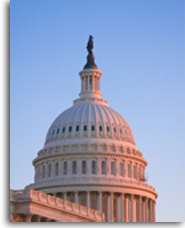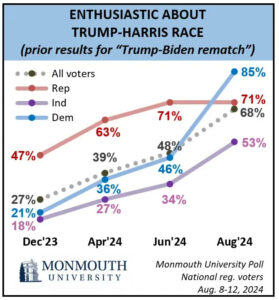The following article by Ruy Teixeira, senior fellow at the American Enterprise Institute, politics editor of The Liberal Patriot newsletter and co-author with John B. Judis of “Where Have All the Democrats Gone?,” is cross-posted from The Liberal Patriot:
The Democrats have had a good two weeks, nosing ahead of Trump in the national polling averages and even in some key swing states. Nate Silver’s prediction model shows the race now as basically a toss-up, with Harris actually on the good end of a 53-47 probability-of-victory split. That’s a dramatic improvement from where the Democrats were in the fading days of Biden’s campaign.
But it’s still a campaign on a knife’s edge that could go either way. Recognizing this, the Harris campaign has sought to remedy Harris’s vulnerabilities on a host of issues where her status as a liberal California Democrat and her publicly-stated past positions put her far away from the median American voter. They know the more voters view her as a moderate and close to the center of American politics, the better her chances of winning the election.
So far, this move to the center has revolved around several strategies. None of them seem very likely to remedy the problem to which they are addressed. They include:
(1) The “I take it back” strategy. Harris has a long record of taking unpopular, even toxic, stances on various policies that played well, at various times, with the progressive wing of the Democratic Party but are not remotely centrist. These include, but are hardly limited to, banning fracking, banning offshore drilling, backing a Green New Deal, mandatory gun buybacks, defunding the police and casting doubt on whether police really improve public safety, abolishing ICE, decriminalizing illegal border crossings, and abolishing private health insurance.
Do you, the median voter, see something there you don’t like? The Harris campaign says: no problem. Harris now takes it back! Whatever she said in the past that seems bonkers, she now enthusiastically disavows.
Of course, these position reversals raise many questions. Why did she have these positions in the first place? Why did she change those positions—what accounts for her conversion? And what is her position now on those contentious policy issues—besides not being for dumb position X? That leads to a second strategy in the moving-to-the-center campaign.
(2) The “No questions please—we’re Democrats!” strategy. The Harris campaign’s current approach to the logical and potentially embarrassing questions raised by these policy reversals has the beauty of simplicity: don’t answer them! In fact, avoid questions entirely by confining Harris’s activities to scripted rallies. After all, you can’t get in trouble for your answers if nobody gets to ask you questions.
The downside of course is it makes the disavowals less convincing, leaving voters wondering whether Harris’s views really have changed and, critically, whether and to what extent Harris’s positions are really centrist and close to their own.
The media has been remarkably tolerant of this strategy which has contributed to the almost 100 percent positive coverage of her campaign so far. While it doesn’t seem like that can last, the Harris campaign certainly hopes it will; they much prefer a “vibes” campaign with only vague policy commitments (the campaign website does not even have an issues section), super-broad themes like “freedom” and social media memes around policy-independent things like “brat,” “coconut tree,” and “weird.”
But perhaps not all the voters they need to reach will be susceptible to a vibes campaign, especially non-online, working-class voters in key states. That brings us to a third moving-to-the-center strategy, designed especially to reach recalcitrant working-class voters.
(3) The “Hey, we’re working class too!” strategy. This appears to be part of the thinking behind the selection of Minnesota governor Tim Walz as Harris’s running mate, instead of Pennsylvania governor Josh Shapiro. Shapiro, of course, was not beloved of the progressive left and their campaign against him and for Walz apparently had an effect. But Shapiro also, in terms of background and personal affect, does not code as working class in a way Walz does. The Harris campaign hopes that his persona will help them reach the working class, particularly white working-class voters, whose support they so desperately need in key Midwestern/Rustbelt states.
There are some problems with this. Walz, while he was a relatively conservative Democrat when he was representing a rural district in the House of Representatives, as governor of Minnesota he has been pretty much a down-the-line progressive. Indeed, in his current incarnation he is more a coastal liberal Democrat’s idea of what white working-class guys from the Midwest should be like rather than what they really are like.
Nor does his electoral record suggest unusual blue collar appeal. Shapiro in 2022 won his governor’s race in Pennsylvania by 15 points in a state with a +3 Republican partisan lean. He outran Biden’s 2020 performance in the state by 14 points. In contrast, Walz won his governor’s race in 2022 by 8 points in a state with a +2 Democratic partisan lean. And he ran ahead of Biden’s 2020 performance in the state but just a single percentage point. Walz also lost white working-class voters in his state by 8 points, 6 points worse than Shapiro did in his race.
An interesting analysis by Steve Kornacki underscores this point. He explains:
Forty-nine of Minnesota’s 87 counties might be considered “Trump surge” counties; that is, Republicans ran at least 20 points better there under Trump in 2016 and 2020 than they had in the 2012 election, when Mitt Romney was the GOP nominee. Those counties are all part of Greater Minnesota, many are rural, and virtually all are overwhelmingly white. The share of white adults without four-year degrees in those counties 72 percent to 85 percent.
Demographically, those counties almost perfectly fit the mold of the swaths of Wisconsin, Michigan and Pennsylvania where Democrats have lost the most ground in the Trump era. They were also, before Trump, politically competitive, and some even voted for Barack Obama in 2012. In other words, these are the first counties you’d look at to assess whether Walz has unique appeal where his party has experienced its most dramatic Trump-era slide.
As it turns out, Walz had no special appeal in these counties; his performance was similar to Biden’s but vastly inferior to how Obama did in 2012. Kornacki adds:
“What’s striking…is how different the Walz and Biden numbers are from Obama’s. When Obama won his two elections, he joined strong metro-area support with respectable showings (and sometimes better) among small-town and blue-collar voters. A primary feature of American politics since Obama has been the virtual disappearance of that kind of demographic and geographic balance from the Democratic coalition.
In his ’22 campaign, Walz didn’t restore that old balance. His coalition, instead, looked just like what has become the standard post-Obama coalition for Democrats. He rolled up massive margins in metro areas and took a beating practically everywhere else.
This is consistent of course with my analysis from last week, “The Harris Coalition Is *Not* the Second Coming of the Obama Coalition.” It’s also consistent with a fascinating new piece by the New York Times’s Jess Bidgood on Walz campaigning in Wisconsin, which suggests what the Harris-Walz campaign in the Midwest may really be about:
Eau Claire is a deep blue college town, and it’s far from clear that the appeal of the governor from the other side of the St. Croix will translate beyond liberal bastions like this one and expand his ticket’s competitive terrain. But as I wound my way through the crowd today, it occurred to me that the Eau Claires of the world might be the main point.
In recent years, Wisconsin Democrats have notched major victories by running up their numbers in strongholds like Madison, La Crosse and Milwaukee. That means Walz was here not simply to sound folksy, talk about hunting and reach out to rural voters. His purpose, electorally speaking, is to fire up Wisconsin progressives who wish their state was just a little more like his….
The Harris campaign is betting that leaning into Walz’s unabashed progressivism might work—and, given Wisconsin’s famous swinginess, that comes with some risk. But Dane County, the Democratic stronghold that contains Madison, is growing rapidly….
Tim McCarthy, 60, a teacher from the college town of Ripon, said he was thrilled both to see Walz and to be at a rally with “like-minded people.”
“There’s a lot of conservatism in northern Wisconsin that you’re not going to shake loose,” McCarthy said. “They’ll support Trump no matter what.”
But he thought that Walz would catch on in his town—and suggested that the campaign might not even need to bother with more conservative parts of the state.
Hmm. Very interesting, if questionable as a political strategy. In the end, an attempt to move to the center that does not involve actively embracing centrist, moderate positions—as appears to be the current Harris campaign strategy—may fall short of its political goals. Jonathan Chait makes the case well:
Rather than move to the center on policy, they [the left] hope nominating candidates with a reassuring personal affect and personal biography can reassure moderate voters.
Walz generates so much enthusiasm on the left in part because he represents the apotheosis of this strategy….
But at the end of the day, issue positioning matters a lot. There is a reason Walz is less popular in a light-blue state than Josh Shapiro is in a purple state—indeed, when Walz shared a ballot in his own state with the moderate Amy Klobuchar [2018], her victory margin (24 points) was more than double his (11.4 points). It’s not because Walz is less likable than Shapiro or Klobuchar. It’s because he’s less moderate.
Walz had a fairly conservative voting record in Congress, where he represented a red district. He used that record to win the governorship, and then moved sharply left. The lesson he seems to have taken from this experience is that there is no cost in adopting progressive positions across the board. “Don’t ever shy away from our progressive values,” Walz said on a recent call. “One person’s socialism is another person’s neighborliness.”
I can’t emphasize enough what a bad idea this is. On issues where progressive values are unpopular, and there are several, Democrats should definitely shy away from progressive values. For example, their stance on socialism, which is an extremely unpopular concept, should not be to liken it to neighborliness, but to say it’s bad and promise not to do it….
What the selection does…is forfeit her best opportunity to send a message that she is a moderate. She needs to take every possible opportunity between now and November to make up for that. Harris needs to adopt positions that will upset progressive activists. She needs to specifically understand that the likelihood a given action or statement will create complaints on the left is a reason to do something, rather than a reason not to.
That is an approach to moving to the center the Harris campaign has apparently ruled out. If that is the case, Donald Trump, with all his unattractive qualities and unforced political errors, is likely to remain competitive through November and, let’s face it, could easily win. As Chait puts it, somewhat wistfully, “I don’t want to bet the future of this country on a coin toss. I want to build a political coalition with a clear majority.” Unfortunately, it looks far more likely he’ll get the former than the latter.










